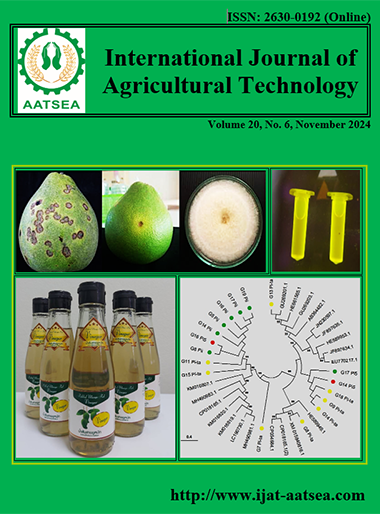Vinegar production from pickled mango peel waste
Main Article Content
Abstract
The pickled mango industry was found to reduce waste by fermenting pickled mango peel into vinegar. The results revealed that a 1:4 ratio of mango pickle peel to water resulted in the highest ethyl alcohol content production, with a significant difference (p≤ 0.05). Moreover, a 15 % (v/v) acetic acid culture showed significantly (p≤ 0.05) high acetic acid content. The produced pickled mango peel vinegar was then subjected to sensory evaluation and compared with commercial apple cider vinegar. Interestingly, the produced vinegar exhibited significantly (p≤ 0.05) higher aroma, taste, and overall acceptability compared to the commercial vinegar, although there were not significant differences in color and texture. Overall, this study represents a novel approach to vinegar production from pickled mango waste, contributing to waste reduction and environmental sustainability
Article Details

This work is licensed under a Creative Commons Attribution-NonCommercial-NoDerivatives 4.0 International License.
References
AOAC (2025). Official method of Analysis. 18th Edition, Association of Officiating Analytical Chemist, Washington DC, USA.
Boonsupa W., Phonkan, K., Kaewkaset, J., Chandongang, T., Nantarit, K. and Buapat, K. (2017). Chemical Property, Antioxidant Activity and Sensory Evaluation of Fermented Vinegar from 4 Cantaloupe. Cultivars. Ubon Ratchathani University of Science and Technology Journal, 19:187-196. (In Thai)
Budak, N. H., Aykin, E., Seydim, A. C., Greene, A. K. and Guzel-Seydim, Z. B. (2014). Functional properties of vinegar. Journal of Food Science, 79:r757-r763.
Chiemchaisri, C., Juanga, J. P. and Visvanathan, C. (2007). Municipal solid waste management in Thailand and disposal emission inventory. Environmental Monitoring and Assessment, 135:13-20.
Coelho, E., Genisheva, Z., Oliveira, J. M., Teixeira, J. A. and Domingues, L. (2017). Vinegar production from fruit concentrates: effect on volatile composition and antioxidant activity. Journal of Food Science and Technology, 54:4112-4122.
García-Mahecha, M., Soto-Valdez,H., Carvajal-Millan, E., Madera-Santana, T., Lomelí-Ramírez, M. and Colín-Chávez, C. (2023). Bioactive compounds in extracts from the agro-industrial waste of mango. Molecules, 28:1-17.
Giuffre, A. M., Zappia, C., Capocasale, M., Poiana, M., Sidari, R., Donna, L. D., Bartella, L., Sindona, G., Corradini, G., Giudici, P. and Caridi, A. (2019). Vinegar production to valorise Citrus bergamia by-products. European Food Research and Technology, 245: 667-675.
Hailu, S., Admassu, S. and Jha, Y. K. (2012). Vinegar production technology- An overview. Beverage & Food World, 29-32.
Ho, C. W., Lazim, A. M., Fazry, S., Zaki, U. K. H. H. and Lim, S. J. (2017). Varieties, production, composition and health benefites of vinegars: A review. Food Chemistry, 221:1621-1630.
Iqbal, S., Bhanger, M. I. and Anwar, F. (2005). Antioxidant properties and components of some
commercially available varieties of rice bran in Pakistan. Food Chemistry, 93:265-272.
Kulkarni, S. J. (2015). Research and studies on vinegar production- A review. International Journal of Scientific Research in Science and Technology, 1:146-148.
Luzon-Quintana, L. M., Castro, R. and Duran-Guerrero, E. (2021). Biotechnological processes in fruit vinegar production. Foods, 10:1-23.
Mongkontanawat, N., Phuangborisut, S., Boonna, S. and Nitteranon, V. (2023). β-Glucan production of Saccharomyces cerevisiae by using mango-fermented wastewater. International Journal of Agricultural Technology, 19:2555-2572.
Prisacaru, A. E. and Oroian, M. A. (2018). Quality evaluation of vinegar obtained from banana peel. 18th International Multidisciplinary Scientific Geo Conference SGEM 2018. p 259-264.
Roda, A., Faveri, D. M. D., Dordoni, R. and Lambri, M. (2014). Vinegar production from pineapple waste-preliminary saccharification trials. Chemical Engineering Transactions, 37:607-612.
Taweekasemsombut, S., Tinoi, J., Mongkornasawakul, P. and Chandet, N. (2021). Thai rice vinegar: Production and biological properties. Applied Science, 11:1-18.
Helge, TS. (2009). Statistical Analysis of Designed Experiments. Third Edition, Springer New York Dordrecht Heidelberg, London, p.1-22.


